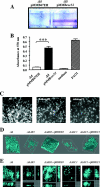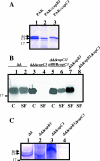Assembly of fimbrial structures in Pseudomonas aeruginosa: functionality and specificity of chaperone-usher machineries
- PMID: 17293418
- PMCID: PMC1855894
- DOI: 10.1128/JB.00093-07
Assembly of fimbrial structures in Pseudomonas aeruginosa: functionality and specificity of chaperone-usher machineries
Abstract
Fimbrial or nonfimbrial adhesins assembled by the bacterial chaperone-usher pathway have been demonstrated to play a key role in pathogenesis. Such an assembly mechanism has been exemplified in uropathogenic Escherichia coli strains with the Pap and the Fim systems. In Pseudomonas aeruginosa, three gene clusters (cupA, cupB, and cupC) encoding chaperone-usher pathway components have been identified in the genome sequence of the PAO1 strain. The Cup systems differ from the Pap or Fim systems, since they obviously lack numbers of genes encoding fimbrial subunits. Nevertheless, the CupA system has been demonstrated to be involved in biofilm formation on solid surfaces, whereas the role of the CupB and CupC systems in biofilm formation could not be clearly elucidated. Moreover, these gene clusters were described as poorly expressed under standard laboratory conditions. The cupB and cupC clusters are directly under the control of a two-component regulatory system designated RocA1/S1/R. In this study, we revealed that Roc1-dependent induction of the cupB and cupC genes resulted in a high level of biofilm formation, with CupB and CupC acting with synergy in clustering bacteria for microcolony formation. Very importantly, this phenotype was associated with the assembly of cell surface fimbriae visualized by electron microscopy. Finally, we observed that the CupB and CupC systems are specialized in the assembly of their own fimbrial subunits and are not exchangeable.
Figures





Similar articles
-
A novel two-component system controls the expression of Pseudomonas aeruginosa fimbrial cup genes.Mol Microbiol. 2005 Jan;55(2):368-80. doi: 10.1111/j.1365-2958.2004.04402.x. Mol Microbiol. 2005. PMID: 15659157
-
The chaperone/usher pathways of Pseudomonas aeruginosa: identification of fimbrial gene clusters (cup) and their involvement in biofilm formation.Proc Natl Acad Sci U S A. 2001 Jun 5;98(12):6911-6. doi: 10.1073/pnas.111551898. Epub 2001 May 29. Proc Natl Acad Sci U S A. 2001. PMID: 11381121 Free PMC article.
-
Biofilm formation in Pseudomonas aeruginosa: fimbrial cup gene clusters are controlled by the transcriptional regulator MvaT.J Bacteriol. 2004 May;186(9):2880-90. doi: 10.1128/JB.186.9.2880-2890.2004. J Bacteriol. 2004. PMID: 15090530 Free PMC article.
-
Biofilm formation by the small colony variant phenotype of Pseudomonas aeruginosa.Environ Microbiol. 2004 Jun;6(6):546-51. doi: 10.1111/j.1462-2920.2004.00618.x. Environ Microbiol. 2004. PMID: 15142242 Review.
-
FGL chaperone-assembled fimbrial polyadhesins: anti-immune armament of Gram-negative bacterial pathogens.FEMS Microbiol Rev. 2007 Jul;31(4):478-514. doi: 10.1111/j.1574-6976.2007.00075.x. FEMS Microbiol Rev. 2007. PMID: 17576202 Review.
Cited by
-
Pseudomonas aeruginosa Biofilm Lifecycle: Involvement of Mechanical Constraints and Timeline of Matrix Production.Antibiotics (Basel). 2024 Jul 24;13(8):688. doi: 10.3390/antibiotics13080688. Antibiotics (Basel). 2024. PMID: 39199987 Free PMC article. Review.
-
How bacteria recognise and respond to surface contact.FEMS Microbiol Rev. 2020 Jan 1;44(1):106-122. doi: 10.1093/femsre/fuz029. FEMS Microbiol Rev. 2020. PMID: 31769807 Free PMC article. Review.
-
Expression of Pseudomonas aeruginosa CupD fimbrial genes is antagonistically controlled by RcsB and the EAL-containing PvrR response regulators.PLoS One. 2009 Jun 23;4(6):e6018. doi: 10.1371/journal.pone.0006018. PLoS One. 2009. PMID: 19547710 Free PMC article.
-
The 'P-usher', a novel protein transporter involved in fimbrial assembly and TpsA secretion.EMBO J. 2008 Oct 22;27(20):2669-80. doi: 10.1038/emboj.2008.197. Epub 2008 Oct 2. EMBO J. 2008. PMID: 18833195 Free PMC article.
-
A novel Pseudomonas aeruginosa bacteriophage, Ab31, a chimera formed from temperate phage PAJU2 and P. putida lytic phage AF: characteristics and mechanism of bacterial resistance.PLoS One. 2014 Apr 3;9(4):e93777. doi: 10.1371/journal.pone.0093777. eCollection 2014. PLoS One. 2014. PMID: 24699529 Free PMC article.
References
-
- Choudhury, D., A. Thompson, V. Stojanoff, S. Langermann, J. Pinker, S. J. Hultgren, and S. D. Knight. 1999. X-ray structure of the FimC-FimH chaperone-adhesin complex from uropathogenic Escherichia coli. Science 285:1061-1066. - PubMed
-
- de Oliveira-Garcia, D., M. Dall'Agnol, M. Rosales, A. C. Azzuz, N. Alcantara, M. B. Martinez, and J. A. Giron. 2003. Fimbriae and adherence of Stenotrophomonas maltophilia to epithelial cells and to abiotic surfaces. Cell. Microbiol. 5:625-636. - PubMed
Publication types
MeSH terms
Substances
LinkOut - more resources
Full Text Sources
Research Materials

